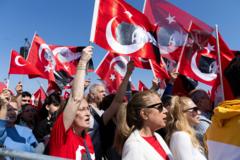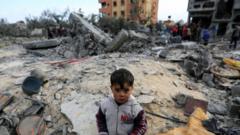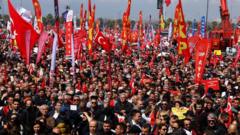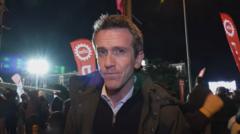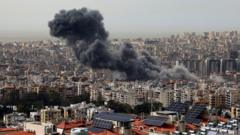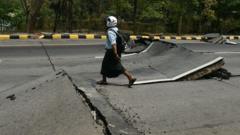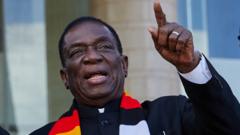In a pivotal moment for Gazan residents, protests against Hamas's long-standing rule are emerging amidst the chaos of ongoing conflict with Israel.
Protests Erupt in Gaza Against Hamas Amid Ongoing Conflict

Protests Erupt in Gaza Against Hamas Amid Ongoing Conflict
Public demonstrations in Beit Lahia signal a shift in Palestinian sentiment towards Ham
Article text:
As tensions escalate in the region, the residents of Beit Lahia, a northern community in Gaza, have taken to the streets to voice their demands for an end to the war and the end of Hamas’s nearly two-decade rule. Protests erupted following an Israeli airstrike on a central building in Beit Lahia on Monday night, which came shortly after an evacuation order from the Israeli military. The airstrike rattled the community and prompted residents to act, demonstrating a significant challenge to Hamas's authority amidst the turmoil.
Participants in the demonstrations have expressed their desire for change. Ahmad al-Masri, a local resident who played a role in organizing the protests, called for Hamas to relinquish control, emphasizing that continued rule would only lead to further bloodshed, destruction, and warfare. “Hamas needs to go away,” he stated passionately.
Despite the protests being relatively modest in scale, they represent a bold awakening of public sentiment against Hamas since the violent onset of the current conflict in October 2023 following a Hamas-led attack on Israel. Such expressions of dissent underscore a growing frustration among Palestinians who find themselves once again facing round-the-clock bombardments after a failed attempt to extend a cease-fire agreement.
In a stark shift from previous instances where Hamas maintained a strict grip on dissent through violent suppression, observers noted the organization’s security forces were noticeably absent during the latest protests. Analysts suggest that this could reflect both the precarious position Hamas finds itself in as it faces mounting discontent among the populace and its diminished capacity to retaliate without exacerbating tension with the community.
The initial protest in Beit Lahia occurred around 4 p.m. on Tuesday and was coordinated through community messages circulating among local residents. A graphic shared on social media conveyed the urgency of the situation, inviting citizens to gather and demand peace: “The square is calling on you. Enough of wars. We want to live in peace.”
The series of protests is gaining momentum, with other towns within the devastated enclave witnessing similar demonstrations. As Gazans express their urgency for a swift end to their current plight, it remains uncertain how Hamas will navigate this wave of dissent and what ramifications it may bring for the future of governance in Gaza.
As tensions escalate in the region, the residents of Beit Lahia, a northern community in Gaza, have taken to the streets to voice their demands for an end to the war and the end of Hamas’s nearly two-decade rule. Protests erupted following an Israeli airstrike on a central building in Beit Lahia on Monday night, which came shortly after an evacuation order from the Israeli military. The airstrike rattled the community and prompted residents to act, demonstrating a significant challenge to Hamas's authority amidst the turmoil.
Participants in the demonstrations have expressed their desire for change. Ahmad al-Masri, a local resident who played a role in organizing the protests, called for Hamas to relinquish control, emphasizing that continued rule would only lead to further bloodshed, destruction, and warfare. “Hamas needs to go away,” he stated passionately.
Despite the protests being relatively modest in scale, they represent a bold awakening of public sentiment against Hamas since the violent onset of the current conflict in October 2023 following a Hamas-led attack on Israel. Such expressions of dissent underscore a growing frustration among Palestinians who find themselves once again facing round-the-clock bombardments after a failed attempt to extend a cease-fire agreement.
In a stark shift from previous instances where Hamas maintained a strict grip on dissent through violent suppression, observers noted the organization’s security forces were noticeably absent during the latest protests. Analysts suggest that this could reflect both the precarious position Hamas finds itself in as it faces mounting discontent among the populace and its diminished capacity to retaliate without exacerbating tension with the community.
The initial protest in Beit Lahia occurred around 4 p.m. on Tuesday and was coordinated through community messages circulating among local residents. A graphic shared on social media conveyed the urgency of the situation, inviting citizens to gather and demand peace: “The square is calling on you. Enough of wars. We want to live in peace.”
The series of protests is gaining momentum, with other towns within the devastated enclave witnessing similar demonstrations. As Gazans express their urgency for a swift end to their current plight, it remains uncertain how Hamas will navigate this wave of dissent and what ramifications it may bring for the future of governance in Gaza.


